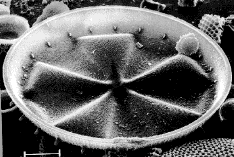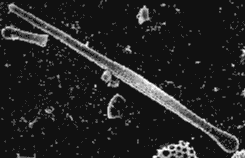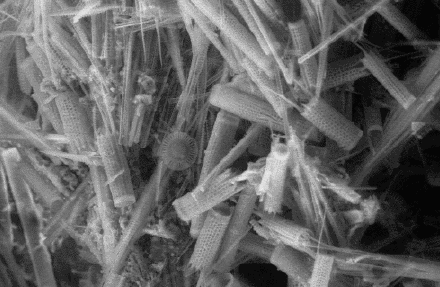







The oldest certain fossil diatoms are Lower Cretaceous in age. Diatoms probably had a much longer history than this; there are reports of Precambrian and Triassic fossils that might be diatoms or diatom relatives, but definite fossil diatoms older than the Cretaceous are not known. An older report of diatoms from the Upper Jurassic is now doubted by experts. Since silica recrystallizes under pressure, any older diatom fossils may have been destroyed.
Most diatom fossils known are from Eocene and Miocene rocks, such as the marine diatoms shown below. At left is a single valve from the Actinoptychus heliopelta, while at right is Sceptroneis caduceus. Both of these are from marine deposits of Miocene age, the Calvert Formation of Maryland.


The richest sources of diatom fossils are deposits of their skeletons known as diatomite, or diatomaceous earth. This mineral was formed as ancient diatoms died and settled to the bottom of lakes or oceans. Today, they form large deposits of white chalky material, which is mined for use in cleansers, paints, filtering agents, and abrasives. Many toothpastes contain bits of fossil diatoms.
In seasonal lakes, diatom deposits may even occur in layers which correspond to annual cycles. In these deposits, it is possible to observe changes over many years which are recorded, providing information about past environments. Below you can see a picture of a lake deposit taken with the UCMP E-SEM, showing many kinds of diatoms.

These photographs were provided by UCMP Museum Scientist Dr. Karen Wetmore. For more photographs of diatoms, visit the Algal Microscopy and Image Digitization server at Bowling Green State University.


